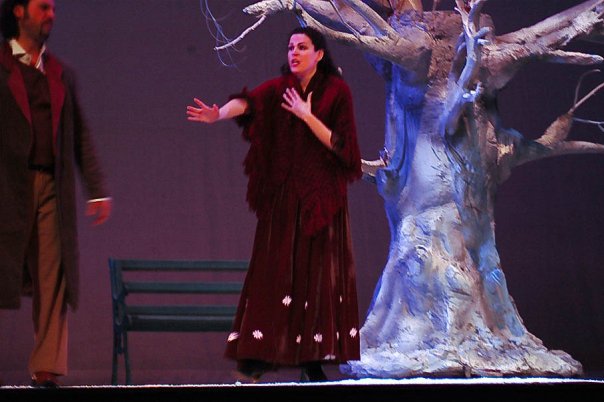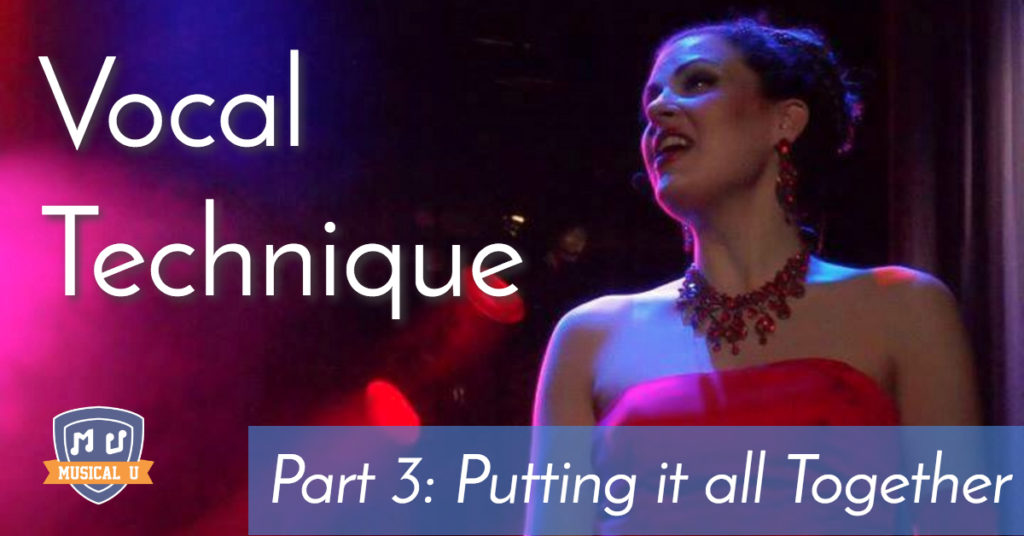What separates the wheat from the chaff in singing? Anyone can shout – it’s those singers who are able to control the voice to the extent that they can willfully communicate the emotion of the text with diverse vocal colors that really stand out from the crowd. After all, the lyrics are the most important part of the art of vocal performance so logically the more tools a singer has with which to communicate the better.
In Part 1 of this three-part series on vocal technique I discussed the foundation for good singing. In Part 2 I discussed how to create space for you voice by lowering the tongue and forming vowels. In the third and final part of this series I will show you how to put everything together to make a sound that is beautiful, rings naturally, is sturdy and under your control.
Squillo della Voce and Chiaroscuro
Have you ever heard a recording of yourself speaking and said, “Do I really sound like that?” A strange part of being a singer is that you can never hear in your head what the audience hears when you sing.

Sometimes you think you’re singing correctly because you’ve managed to manufacture a false sense of size either by sending the sound too far forward into the nose or too far back into the throat. Sending the sound forward into the nose, or “mask”, creates the illusion of a big sound in your own head but doing this actually makes the voice smaller, and, well, nasal-sounding. The other extreme, sending the sound back into the throat, is like singing in a cavern. This creates a false sense of a large, warm sound when in fact it’s “covered” and muted.
With proper placement of sound, you achieve what is called squillo della voice, or the “ring of the voice”, which is a bright, brilliant sound. Squillo is created by finding the correct space for Italian’s bright vowels, your natural resonators and a solid appoggio – diaphragm support.
Ideally, you should find a balance in vocal color between the brightness of your squillo and the warmth that you’ve created by providing depth and space for the voice. This technique is called “chiaroscuro”, which literally means “light-dark”, and typifies the Italian sound of opera singing.
A wonderful example of squillo della voce comes from Italian Tenor Franco Corelli. Have a listen to how clear and bright his voice rings while singing the aria “Vesti la giubba” from Pagliacci (1892) by Ruggero Leoncavallo.
Legato – The Ultimate Goal
Ultimately, the goal of the Traditional Italian Method of Singing is to create a seamless line of sound from one end of your range to the other. This is difficult to do because the voice inherently passes through areas of changing resonance. However if you’re allowing the voice to resonate naturally, you will be well on your way to creating the only perfect possible skill in singing – legato, which comes from the Italian verb “legare”, meaning “to bind” or “to link” (like Legos!).
Not only does the proper placement of vowels help in the creation of squillo and chiaroscuro, those vowels help you to sing legato. If you are able to smoothly move from from one vowel to the next without changing or dropping the internal space, you have an important tool in forming legato.
To learn legato, do the following exercise:
Remember, the Italians say, “si canta come si parla” – “one sings as one speaks.” Begin in the middle/lower part of your range – the part of your voice where you naturally speak. Sing a descending triad on the syllable “ma”. Your lips should only very gently touch to form the consonant and the execution of the triad ought to be very relaxed. Be sure to keep the vowels in the same internal position and not drop them. This exercise will be the bread and butter of your singing technique. After all, if you can’t put three notes together how will you sing an aria?
La Divina
At the risk of starting a heated discussion on who is the greatest opera singer, my opinion is that Maria Callas is the greatest opera singer known to us because she “got the most right”. Opera is a craft that relies on more than one skill – opera singers must not only be able to sing beautifully with a proper technique, but must also be excellent stage actors and most importantly, interpreters of the lyrics. Callas excelled in all of these areas.
She also made singing look effortless because of her extraordinary ability to sing legato. Here is Callas singing the aria “Casta diva” from Vincenzo Bellini’s opera Norma (1831). Her singing appears effortless, almost lazy. At times she hardly even opens her mouth. This is because all the hard work is being done internally – she has a solid appoggio, her resonators are vibrating to amplify the sound, she’s created proper space, she’s keeping the vowels in the same space and her voice is “squillante”. Her artistic performance is nearly flawless.
Scivolata
Sometimes even the great singers “cheat” a little! One way you can make singing slightly easier for yourself without too much fanfare is to make a “scivolata” – or a mini-ascending portamento – into certain sustained notes. “Scivolata” comes the Italian word “scivolare”, which means “to slide”- you slide into the note. This will help you not only in the creation of legato but to lock-in support and direct your sound to the center of the tone.
Have a listen to Italian Lyric Soprano Renata Tebaldi singing “Un bel dì vedremo” from Madama Butterfly (1904) by Giacomo Puccini.There are scivolatas into nearly every sustained note in her first few phrases.
Fila Della Voce
When you sing, you should think of the sound as going straight out the top of your head in a vibrating column of air, as if there is a string attached to the top of your head and pulling you up.
One of the most difficult abilities to achieve with the voice is to sing “pianissimo legato”, or smooth, quiet singing. “Fila della voce”, which means “thread of the voice” in Italian, is a beautiful pianissimo color that is very difficult to learn as it requires just as much – if not more – support from the diaphragm and an exceptional ability to control the voice. Fila della voce is achieved by passing a narrow, vertical, sustained column of air through the vocal chords. Once mastered, you can apply it all types of vocal genres as it’s a potent weapon in your arsenal of vocal colors and effects.
A helpful exercise to learn fila della voce and the art of pianissimo is to take the voice from soft to loud to soft again on a single pitch. It’s very hard to master at first, but very rewarding once you get it.
“Io son l’umile ancella” is an aria from Adriana Lecouvreur (1902) by Francesco Cilea. Italian Soprano Magda Olivero’s stunning ability to sing fila della voce is on display at [2:20] and again at [3:55].
You Only Get One Voice
It’s important to start slowly when learning to sing. Most classical singers start on German Lieder and art songs instead of opera arias right away. These “mini arias” are great tools to learn how to control the voice without stressing the vocal chords.
Even though you may be able to sing a variety of genres, it’s best to focus on just one at a time. (That doesn’t mean you can’t change genres as you career progresses if you wish.) Like countless pop divas who over-extended their voices, Maria Callas somewhat lost her voice in her 40’s. At the age of 26, she sang the heavy dramatic soprano role Brünnhilde in Richard Wagner’s Die Walküre during the same week she first appeared as Elvira in Vincenzo Bellini’s I puritani, a much lighter lyric coloratura role. This feat speaks to her remarkable abilities yet also raises the possibility that just because you can do something doesn’t necessarily mean you ought to do it.
The voice can handle these kind of vocal extremes at 26 but by the mid-thirties the wear and tear catches up with you and vocal problems arise. As you age, your muscles simply don’t have the same elasticity as they did in your younger years and can no longer “bounce back”. Although there were many contributing factors to Callas’ voice loss including technical issues and perhaps her dramatic weight loss, hard living didn’t help. You only get one voice. Treat it well, especially while you’re young.
You can’t go out and buy a new voice if you break it. There are different schools of thought on vocal technique, on how to grow the voice and preserve it at the same time. I do believe the Traditional Italian Method of Singing has stood the test of time. Take, for example, the above-mentioned Magda Olivero at the age of 84 still singing “Io son l’umile ancella”.
One Technique to Rule Them All
Once you have built solid singing foundation in classical technique, it’s possible to apply these skills to different styles of music because the foundation for singing is the same for all of them. The Traditional Italian Method of Singing builds an intimate awareness and control of one’s own voice: with this awareness, you can methodically apply fine-tuned changes – such as working with a microphone, changes in resonance, diction and style traditions, and more – to move into any style you wish.
As a singer I have moved on from the world of opera. However, I’ve applied the technique I learned in Italy to a wide variety of singing styles including crossover, musical theater, and even healthy, supported belting. I am now a professional jazz singer and the applications of this technique to singing jazz are endless!
The Choice is Yours
Never forget that you are in charge of your own voice and future. Therefore, how you apply what you learn is up to you, including which style you wish to sing or whether or not this is even the right singing technique for you.
Some of the best advice I was ever given as a voice student was a reminder that you are paying your teacher. Not the other way around. There are charlatans out there who will sell you damaging technique then move on to the next victim or will try to make you their instrument or “success” story.
If you are not happy with the way you are singing or if something doesn’t feel right, it’s up to you to protect your voice and your potential career. Take charge and find the right technique, the right teacher, and the right style that will help you grow into a lifetime of singing.







